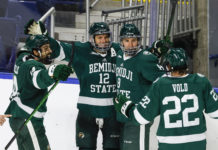It sounds like fans aren’t real happy with the way games are being called in the WCHA so far this season under the rules emphasis designed to crack down on obstruction of the puck carrier.
At least, that’s the way it has come into commissioner Bruce McLeod’s office. He told Kevin Pates of the Duluth News Tribune that for every e-mail saluting the changes, there are 10 condemning them. Last week, he told Brad Schlossman of the Grand Forks Herald that complaints are coming from fans far more than they’re coming from coaches.
It’s understandable. The game wasn’t meant to be a series of 5-on-3s and 4-on-3s, taking away from the natural flow of full-strength play.
But college hockey had to do this, and it had to do it now. Here are two reasons:
** The NHL wants it. Like it or not, the college game is connected to the pro game. That’s the only way a lot of elite players are ever going to come to college in the first place — if it gives them an opportunity to get closer to being a pro-level player.
It’s no secret that NHL scouts and executives weren’t thrilled with the amount of extra work their prospects had to do in college games just to get a scoring chance. Between hooking and holding and obstruction in general, there was more to overcome in college than at the NHL or AHL levels because the pros had already implemented stricter rules on obstructing the puck carrier.
From their perspective, it could be better for their prospect to develop in the minors. That kind of thinking doesn’t bode well for college hockey.
** Goalscoring had to increase. Even with the amount of talent in the WCHA in recent seasons, the league bottomed out in terms of scoring. Blame better defense, better goaltending and more strict systems play if you want, but you also have to throw the kind of infractions that are now being called into the equation, too.
Here’s what I’m having trouble making sense of: Power plays are up in the WCHA this season (14.5 per game) over last (8.8), and goalscoring is up (5.81 goals per game this year, compared to 5.01 last year). But even-strength goalscoring is down (3.24 per game this year, compared to 3.44 a game last season). So while the conference power play percentage is down this season, the number of special teams goals is actually up.
You could drive yourself crazy with these numbers (and I’m getting pretty close), but it seems that even-strength play hasn’t necessarily been helped yet by the rules emphasis. Maybe it’s because there just hasn’t been enough even-strength time in games — a valid concern, and one that takes us back to the original point.
There are going to be growing pains here, probably more than we expected. But the hope is that a better, more free-flowing game emerges out of this. Give it some time.
